Shale gas is never far from the headlines. This week, the former Danish PM who now heads NATO suggested that the Russians might be “actively engaging” with environmental groups in their attempts to stop fracking in the UK.
Far-fetched perhaps, when you consider it was only last year that Greenpeace activists were thrown into a detention centre in Murmansk and accused of piracy.
But the logic is unavoidable; shale offers Europe the best chance to free itself of dependence on Russian gas, if not by extracting its own then by importing the stuff from the US which has plenty to spare.
SGH Martineau hosted a seminar on shale development in its Birmingham office on Friday, with environmental specialists ESI, and the focus was on the impacts of shale development on the UK water sector.
We had some fascinating insights from a range of experts; on drilling, fracking fluids, hydrogeology and wastewater treatment, as well as representatives from the water companies and legal experts from my own firm led by the head of our Planning and Environmental practice David Brammer.
I’m no scientist, but the environmental and safety risks associated with fracking do seem to be very well understood and perfectly manageable. Furthermore, the legal and regulatory framework in the UK might be a little complex and disjointed in places, but it should be up to the job.
When it comes to water, the principal risks associated with fracking seem to be threefold: resource availability for the drilling operations and fracking fluids, contamination to underground water supplies caused by the fracking process, and wastewater disposal on the surface.
Inevitably, comparisons were drawn with experiences in the US. On the first of these, the US experience is that water usage for drilling activities ranks way behind usage for other purposes, notably public water supply, recreation and power generation. The issue in managing supplies is not the overall volumes but the location and frequency of abstraction. For all realistic scenarios of shale development across the UK, our existing infrastructure should be able to cope.
On the second key risk area, contamination to underground aquifers, there seemed to be some consensus on Friday; with current best practice in drilling, the risk of inadvertently creating fractures underground that might contaminate underground water supplies is negligible. Fracking in the UK currently takes place at a depth of around 3km, so if we consider a cross section of sub-strata scaled to the height of a typical room, then the water table is a thin line running inches from the ceiling and the shale formations are typically found at or below the floor level.
That leaves surface wastewater disposal. Wastewater treatment technologies are already available, of course, developed for the conventional oil and gas industry, where production processes produce huge volumes of wastewater.
The challenge is likely to be the widely varying estimates of the quantity of fracking fluids and waste water that comes back up to the surface and can’t be re-used. Without some economies of scale, it’s hard to envisage purpose built treatment works, and of course location and proximity of fracking activities will be key.
What about the legal and regulatory framework?
Well, the Government’s plan, announced in the Queen’s Speech and much publicised, is to change the law to remove the requirement for landowner consent to underground horizontal drilling activity. Whilst the current law might give an entitlement to nominal damages, it does represent a ‘buggeration’ factor for developers and so this change is welcome.
Elsewhere, the patchwork of DECC licensing, local authority and national planning controls, Environment Agency permitting, HSE regulation and so on applying to conventional oil and gas development will apply to fracking for shale gas. As I say, this should be up to the job, and indeed the European Commission will be keeping a close eye on things over the next 12 months or so.
The Commission disappointed many opponents of shale gas in January this year, when (under pressure from UK and its allies, notably Poland) it declined an opportunity to come down hard with tough restrictions on fracking across Europe, instead opting to issue a non-binding ‘recommendation’ to member states that they adopt guiding principles and start reporting on compliance. These principles cover such things as disclosure of contents of fracking fluid, adoption of water management plans and avoidance of water sources under stress.
The Commission has committed to review compliance after 18 months, and so towards the end of next year it could well come back with a more concrete, and binding, position.
That’s probably a sensible compromise, and should allow the UK to move forward within the confines of our current legal and regulatory controls, which are amongst the toughest in the world.
But let’s not fool ourselves that fracking is now going mainstream. It remains a controversial topic, and environmental campaigners will continue to target development sites, with or without Russian money.
Public engagement and community consultation by developers will be crucial in the months and years ahead, as the hype gradually dies down and we begin to reveal the true economic development potential of our domestic shale reserves.
As one might expect, shale gas is a tricky subject to cover in 800 words, so if any reader wants a little more detail, please get in touch and we’ll do what we can.























